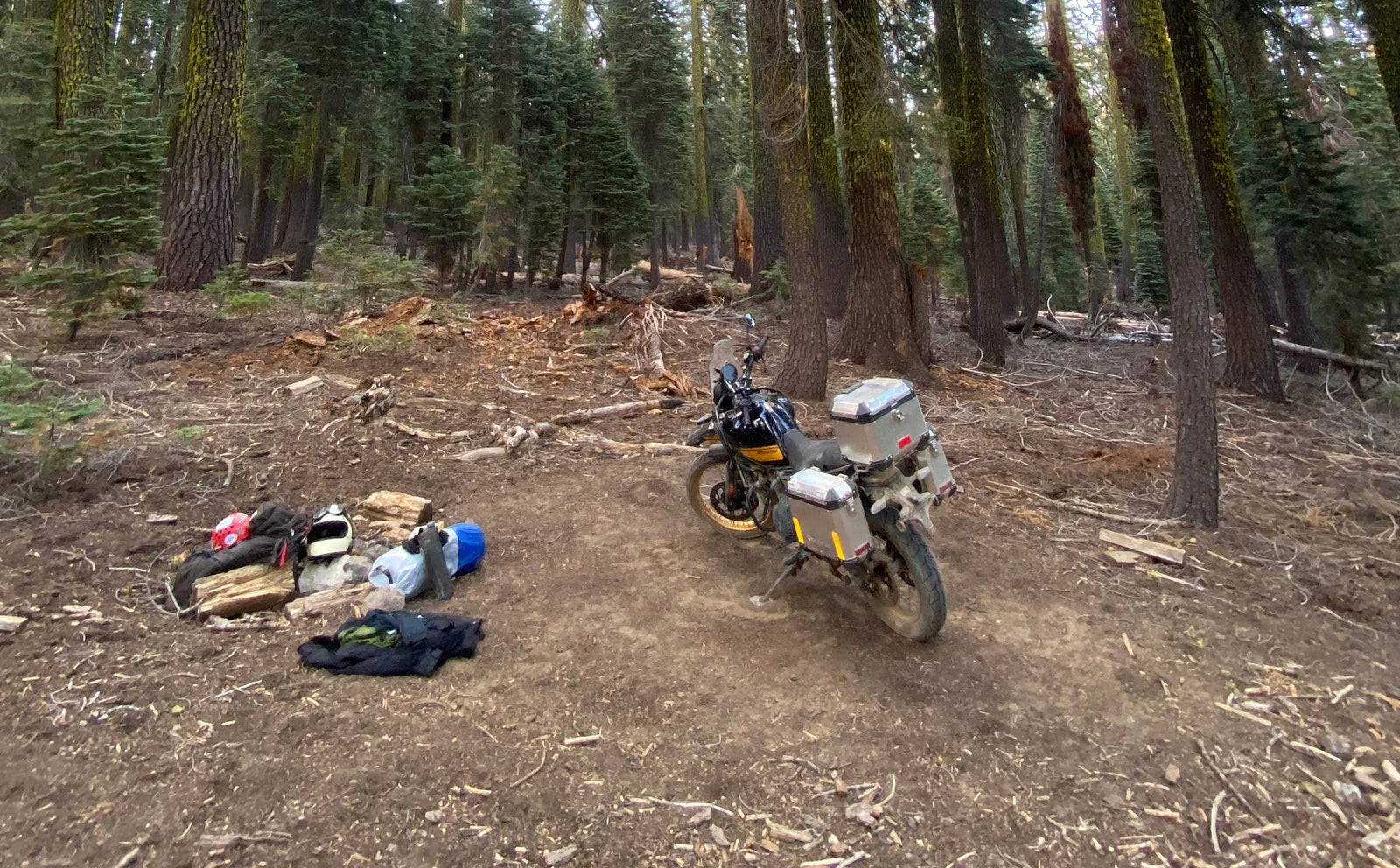Campsites matter. I’ve had this drilled into me over the years by a variety of heinous scenarios, but I best remember the first. I was a 14-year-old Boy Scout, backpacking with my troop on the Appalachian Trail in North Carolina.
On this trip, as on many others, I was buddied up with a guy I’ll call Charlie. Charlie had a developmental disorder, and everyone in the troop loved the guy, but he could be a lot. He was a beefy, sweaty, high-energy fellow, with a penchant for wrestling, making noise, slapping folks on the back with the force of a sledgehammer, and sneaking into the supply trailer, scarfing down copious amounts of snacks, then vomiting.
Charlie and I were tentmates on this outing, and it was my job to take care of him. He’d already eaten his entire food allowance for our weeklong trip, so he and I were splitting my food stash, and stoke was low.
Our troop stopped for the night along a muddy creek. As we divvied out tent sites, Charlie and I drew the short straw. We were supposed to set up our tent in the lowest site, just a foot or so uphill from the creek.
I awoke in the middle of the night, walloped upside the head with Charlie’s metal flashlight. He was shrieking like a banshee, breakdancing on top of me as he tried to get out of the tent. A monster rainstorm had dumped overnight, and our tent was holding about six inches of water. A WWE-style brawl ensued as we both scrabbled for the zipper. I walked the next three days with soggy gear (and a large knot on my forehead).
This incident was more comical than anything else, but it reflects a simple truth: When you’re sleeping, you’re vulnerable. In some cases, a bad campsite just means wet boots. In others, it could mean an utterly derailed outing, not to mention injury or death.

Choosing a Wilderness Campsite: Do’s and Don’ts
Subjective vs. Objective Hazards
All hazards in the wilderness are subjective or objective.
- Subjective hazards are personal risks that we can control. These include things like the gear and apparel we bring, the level of planning we do, our fitness and experience, the routes we choose, and the decisions we make. (Turn back? Keep going? Try to get a selfie with that grizzly bear?).
- Objective hazards are environmental risks that are outside our control, such as rockfall, landslides, wildfires, falling trees, avalanches, endemic flora and fauna, and inclement weather.
Safe wilderness camping hinges on solid decision-making, eliminating objective hazards and minimizing the risk of objective hazards. More on this later.

Six Steps for a Safe, Solid Campsite
1. Plan Ahead
This is the most important step. Do your due diligence before heading into the wilderness. Map out campsites you plan to use, check the weather forecast and trail conditions, and ensure you’re aware of current wilderness regulations.
Ask questions. How long is the maximum stay at your intended campsite? Do you need an overnight permit? What elevation will you be camping at? Where is the closest water source? Do you need to hang bear bags? Are campfires allowed? Are you entering a region with active hunting?
Proper planning also starts with packing the right camping gear. Do you have a big enough tent? Is your sleeping bag rated for the temperatures you’ll encounter? Have you brought the right camping apparel?
I won’t waste more time here, because this is pretty obvious stuff and we could get lost in the sauce going into too much detail about how to pack for a motocamping trip, but the point is that 90% of the battle is fought in your garage or gear closet. Ensure your kit is solid before you swing that leg over your bike and roll out.
2. Choose Level, Stable Ground
Camping on flat, stable ground is crucial. Search for bare, consistent surfaces like rock, snow, dirt, sand, or dead leaves. Avoid soft ground and living vegetation. If a slight angle is present, situate yourself with your head on the uphill side.
TIP: Your motorcycle is a hazard on uneven ground, particularly if you’re camping next to it. I would not want my skull on the receiving end of a falling GS handlebar. Even if the ground feels hard-packed when you go to sleep, overnight rain can turn that into soft, loamy dirt. Bring a kickstand plate!

3. Analyze Objective Hazards
Scope your site for objective hazards like flooding, rockfall, and treefall. Avoid camping within 200 feet of rivers, lakes, streams, and other bodies of water. Low-lying areas near water are already risky due to flooding, but they’re also meccas for mosquitos and other biting insects. Steer clear unless you have leather skin!
Don’t camp downhill from steep gradients of loose rock, such as gullies or high-angle talus and scree fields. In winter, scan for avalanche risk, such as snow-logged basins or steep couloirs above you, and signs of past activity, like avalanche debris or swathes of fallen trees. Don’t camp anywhere in the fall zone of dead trees, and—even on living trees—check the integrity of large branches above you. I know a dude who died just last year from a large tree branch falling on him while hiking.
4. Scout Sun Positioning and Windbreaks
Camping higher, as opposed to lower, naturally reduces many risks. But be wary of winds, particularly on cols and saddles. Wind naturally fires through notches in the landscape, so avoid camping at or near the apex of any passes. If camping in wide open areas, such as plains and deserts, consider a campsite with a natural windbreak, such as one sheltered by stands of trees or clumps of boulders. Wind isn’t usually a safety concern, but it’s never comfortable to camp in high winds. It also makes firestarting and cooking difficult and increases wildfire risk.
Sun positioning isn’t so much of a safety concern as it is a comfort one, but it’s still worth a thought. Particularly in cold weather, positioning your tent opening where it will catch the first morning’s rays can be a great way to give yourself an added boost in the morning. By the same principle, in hot climates choose campsites with ample shade.
5. Consolidate, Consolidate, Consolidate
Clean campsites are safe ones. Keeping your gear organized and consolidated prevents stuff from blowing away, makes it easier to get your gear inside in case of rain, minimizes chances of critters nabbing or tearing up gear and food, and also reduces the risk of human thievery while you’re away from your campsite during the day.
I never leave any gear outside of my tent while I’m not around. Most thieves (animal or human) are opportunists. They won’t take the time to zip open a tent fly and dig into a packed bag, but if they see junk lying around, they may nab it.

6. Protect Your Ride
Your motorcycle is your lifeline in the wilderness. Nothing is worse than waking up after a cold night and finding a shot battery, clogged carbs, or some other malady afflicting your ride. This can turn a mellow trip into a nightmare epic.
A few years ago, I took a DR650 up to an alpine hut around 15,000 feet in northern Ecuador to climb Cayambé (18,996ft) the country’s third-tallest peak, and I came down from the mountain amid a blizzard to find my bike completely buried in snow in subzero temps. The bike wouldn’t start, even with a running jump, and I ended up hitching a ride down in the bed of a pickup with some other climbers, coming back to nab the bike once temps heated up the next day.
This was a pretty gnarly situation, and the road was so icy that I didn’t really want to ride until it thawed anyway, but I maybe could’ve prevented my dead battery by tarping the bike or parking it under the overhanging roof of the hut.
Just keep your bike in mind when you camp. Do a pre-trip checkup on basics like battery, tires, brakes, chain, and cables. Bring a basic adventure motorcycle tool kit. Use a stand plate, consider insulating or tarping it if you’re expecting foul weather.
Leaving No Trace at Your Campsite
I’ve covered the history, practices, and principles of sustainable camping via Leave No Trace (LNT) in another blog. Head here to learn how to keep your campsite as low-impact as possible. The good news is that LNT and campsite safety overlap. A safe campsite is usually one that leaves little trace.
In short, look for established campsites if available, camp 200 feet or more from water sources to protect water quality and wildlife habitats, and follow local fire regulations closely, using established fire rings whenever available and ensuring ashes are cool to the touch before you leave. Avoid camping on living vegetation.
Conclusion
Campsites matter. The results of a poorly planned campsite might be as minor as soggy clothes or bug bites, but they could also be serious (rockfall, avalanches, scavenging bears). So when you pitch a tent, do it right. A bomber campsite is the bedrock for a bomber adventure!
Owen Clarke is an American action sports journalist primarily covering rock climbing and adventure motorcycling. He has ridden (and crashed) motorcycles on six continents. Among other roles, he is a frequent contributor to Climbing, Outside, and Summit Journal, and is the Africa Climbs & Expeditions editor for the American Alpine Journal.

